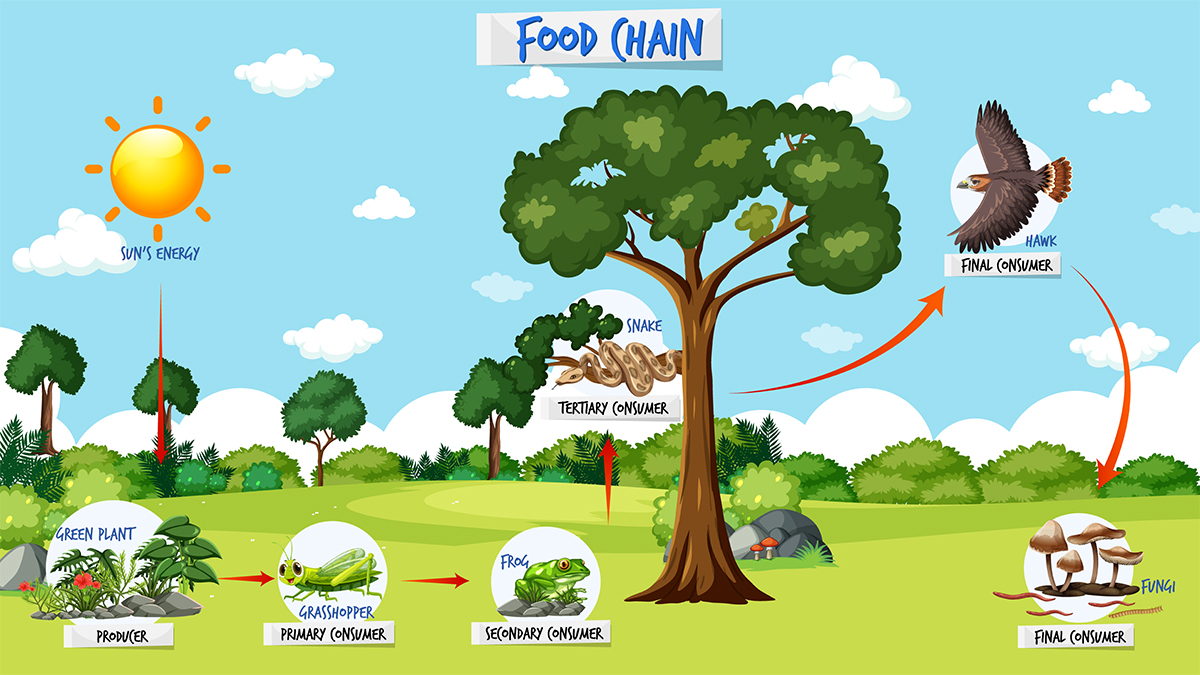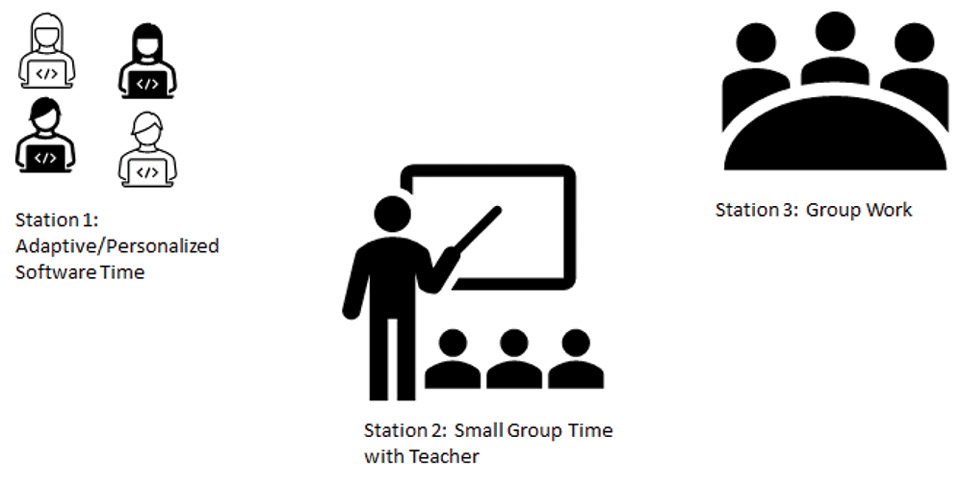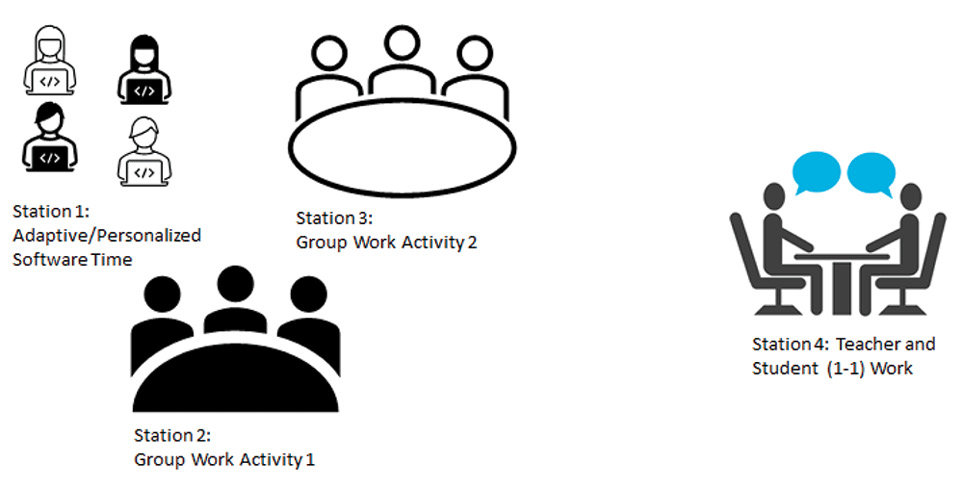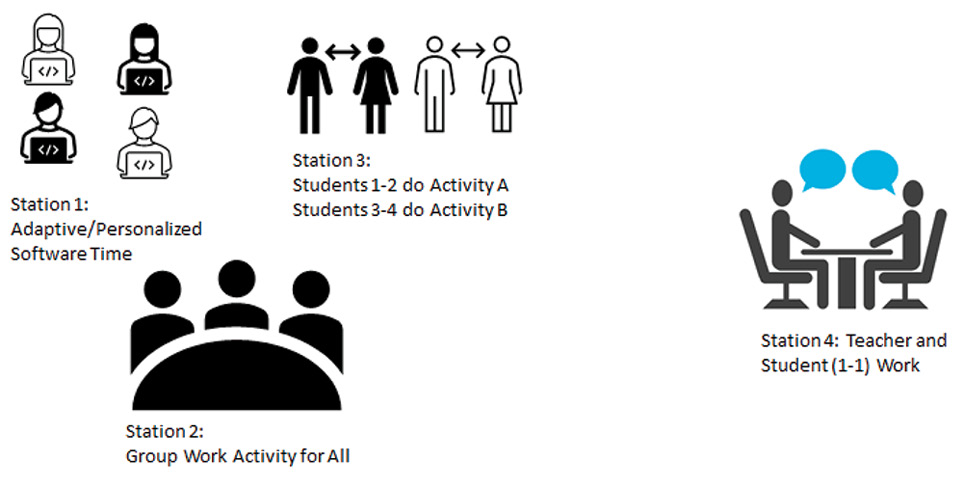feature
Differentiation in the Life Science Classroom Using Station Rotations
Science Scope—May/June 2022 (Volume 45, Issue 5)
By Rebecca Hite, Heather Greenhalgh-Spencer, and Gina Childers

Middle grades science teachers seek avenues to differentiate classroom-based curricular activities to provide more opportunities for their students to master science content and also to create a classroom environment that is both responsive and inclusive to students’ changing and uniquely individualized learning needs. This article addresses this special call for differentiation in all learning environments by elucidating one specific strategy for differentiation—the station rotation model. We begin by describing the station model as an emergent instructional modality, providing a context for its purpose in differentiating curricular activities, and graphically displaying how its varied structure provides teacher flexibility in classroom implementation. Next, we outline a five-step, data-driven, and reflective process to design a station rotation using middle grades science standards on food chains and food webs.
Station rotation is one of many models of teaching and learning that is meant to address the problem of one-size-fits-all instruction. Teachers know, from previous experience as well as from professional development, that students come to class with a lot of variability in background knowledge, skills, cultures, learning preferences, learning strengths, and learning challenges. Station rotation aims to help teachers meet students’ needs and address students’ strengths and challenges through a systematic approach. In station rotation models, the teacher sets up different stations with specific goals and specific approaches. Students rotate through the stations either on a fixed (visiting each station) or individualized (visiting some stations) schedule determined by the teacher. Stations are based on data (from student learning journals, learner profiles, exit tickets, district assessments, etc.) for students to obtain mastery. Additionally, the station rotation model helps the teacher to have more time to meet with students one-on-one, or to pull small groups for more focused support (for more information about the various types of station rotation models, see Maxwell and White 2017).
When considering lab work, teachers may take advantage of the station rotation model to support differentiation. Given that stations are based on data, stations can be designed to specifically address remediation, mastery, and enrichment. For example, Station 1 might use videos and adaptive software that allows students to learn different lessons about specific misconceptions that were identified during analysis of data. Station 2 could offer group work projects where students run experiments focused on mastery experiences. Station 3 could include individualized “expansion” assignments where each student is working on a small report, geared to the needs and interests of students who have already mastered the standard. At Station 4, the teacher could meet with small groups for targeted instruction. An optional fifth station could provide enrichment activities for a group of students (small-group expansion activities) who have already demonstrated mastery of the material, thus providing “expansion” options for both individual students and groups of students.
Station rotation models can be supported through the use of digital technologies. There are many ways to leverage digital technologies to support station rotation models. Sensors, virtual reality systems, and tablets can be used during stations to enhance different ways of learning (e.g., using online programs that allow students to virtually dissect a frog, a cow’s eye, etc.). Content-specific software programs allow the teacher to connect learning to specific student gaps in learning and student goals for learning. Learning Management Systems (such as Google Classroom) are a part of classroom routines that include gathering data for the stations and assigning specific students to go to specific stations. Therefore, using technology becomes part of a universal design for learning toolbox (see CAST 2021) in which every student benefits from using technology.
There are multiple ways to do station rotations. Figures 1–5 show several illustrations of how teachers might put together station rotations to meet the needs of their students. The steps in creating a station rotation are as follows: (1) collecting and analyzing student data prior to the design of the station rotation activities; (2) developing and planning the station rotation activities driven by student data, standard(s), and lesson objectives; (3) implementing station rotation activities with students; (4) collecting and analyzing student data after the completion of the station rotation activities; and (5) reflecting on the station rotation design, implementation, and student formative assessment data.

Station rotation idea #1: Station rotation model with three stations.

Station rotation idea #2: Station rotation model with teacher remediation station.

Station rotation idea #3: Advanced station rotation with personalized stations.

Station rotation idea #4: Advanced station rotation with individualized stations.

Station rotation idea #5: Advanced station rotation with mixed group stations.
Five-step station rotation plan for food webs and food chains
Step 1: Collect and analyze student data
First, collecting and analyzing either summative or formative assessment data enables the teacher to determine which standards should be the focus for the station rotation activities. In this sample lesson, we begin by determining students’ current knowledge of relationships between organisms in an ecosystem, focusing on the role of plants.
Guiding Statement #1: Describe the relationships between organisms in a food web.
Guiding Statement #2: Describe the relationship between photosynthesis and respiration.
Using these guiding statements, we are able to develop an informal assessment called a relationship diagram, which tasks students to describe and explain a relationship concept and draw a picture of the relationship (see link to Figure 6 in Supplemental Materials).
Once students complete the relationship diagram, we review the students’ responses and record the alternate conceptions students had regarding the relationship of living organisms in a food web/chain and the connection between photosynthesis and respiration. Based on the responses to the relationship diagram, thematic student data suggest students believe the following:
- Plants do not produce anything other than food. Some students shared that animals eat plants, and plants make food, but they did not describe oxygen production nor carbon dioxide consumption by plants.
- Food chains are made of predators and prey and nothing else. Some students described only predator and prey relationships, but did not include autotrophs or decomposers as part of the food web. There is no mention of the importance of the Sun’s energy.
- Organisms “higher” in a food web, such as predators, eat everything that is lower in the food web.
To address these issues, we identified the standards from which to design stations’ activities that address these alternate misconceptions, including a remediation and an enrichment station to further support students’ learning experiences.
Step 2: Create station rotations for mastery experiences (activities) connected to the standards
Examination of students’ responses and identification of alternative conceptions, including areas in which students need additional opportunities for mastery, determines the station rotation activities (curriculum) to use with any preferred style of rotation model.
Step 3: Implement station rotation in the classroom
Station rotation implementation and facilitation design is crucial to support student learning and manage classroom behavior expectations. For each station described in Figure 7 (see link to figure in Supplemental Materials), special considerations and resources for each station are shared along with additional considerations for station rotation implementation and facilitation in the classroom. Following are some additional considerations for station rotation facilitation to ensure inclusivity of activities:
- The number of stations and activities therein should be solely based on student data; do not have students completing activities without a clear need to master specific standards.
- Each station should have instructions in accessible text (e.g., larger font sizes and images for students with visual impairments and alternative languages for English language learners). Note that all students will benefit from clearly written and graphically represented instructions on both the student- and station-based graphic organizers.
- Practice with your students on how to rotate between stations to reduce issues related to classroom management. You could use egg timers to help facilitate rotations.
- Each station should be clearly marked with a number and color coded for students to easily identify the station and readily locate the materials for the activity.
- The focal point in the classroom, such as the black/white board or screen, should clearly display the stations of the day and how the rotations will be facilitated.
- Students should receive their own “rotation card” showing the order of the stations they will visit during the class period. To make a rotation card, include the following information: a place for the student’s name and a list of stations you wish for students to visit during the class period. You can include a check box for the student to keep track of which stations they have completed.
- Remember the rule of threes: When designing and implementing a station rotation for the first time or even the first few times, sometimes events will not go as planned! It takes three hours to plan a station rotation and three weeks for students to become accustomed to moving around the classroom to stations.
- Station rotations do not have to be utilized every day in the classroom. Design station rotations when they make sense for the students (based on their assessment data). Sometimes station rotations can be used as an introduction to a new topic, a review for a unit, or as a way of connecting a previous unit or content to a new unit or topic.
Step 4: Collect and analyze student data again for curriculum evaluation
In this step, utilize formative and summative assessments to explore the efficacy of your differentiated intervention. An exit ticket provides bookended information to ascertain student growth toward mastery. You may wish to mirror your exit ticket after your entrance ticket (see link to Figure 6 in Online Supplemental Materials) or use a more open-ended means of assessing student progress and future station content or design (see link to Figure 8 in Supplemental Materials). It is recommended to ask students what additional experiences and resources they may need to obtain mastery. This specific question will help inform future stations and the activities therein. If you do not wish to use open-ended questions, you can opt for selected response items that are related to the issues identified in your entrance ticket and to the content of the stations. You can also review student work completed at each station for another source of data to assess the efficacy of the stations in providing mastery experiences.
Step 5: Reflect on student mastery and station rotation facilitation
Reflection is vital in improving planning, implementation, and evaluation to foster student learning and is often ignored or forgotten. Future effective facilitation of this station rotation design and other instructional activities are heavily dependent on reflection and review of student data. The information processed during a reflection debrief may change and enhance how the station rotation is designed, implemented, and evaluated with future classes to improve the facilitation and learning experience for all in the classroom. Some reflections questions are:
- How was the station rotation design effective for student learning? What worked well?
- What was challenging in implementing and facilitating the station rotation for student learning? How might I address these challenges for the next station rotation implementation?
- How were students collaborating, sharing, and discussing with one another?
- Were there any classroom management issues that occurred during the class? How might I structure the station rotation facilitation differently to alleviate these issues?
- Were students being challenged? Was student learning being supported throughout the process?
- What evidence was collected to determine student learning? How might I collect student data differently to know more about students’ knowledge and skills?
Conclusion
Multiple studies have found that station rotation models—particularly station rotation models that use data-driven instructional practices and blended learning strategies—support inclusive classroom instruction, student engagement, student perceptions of belonging, and attention to diversity and equity (Callahan 2021; Kaspar 2018; Nickels and Gartner 2018; Rivera 2017). Station rotation models allow science teachers to meet students’ changing needs and to challenge each student to deepen their knowledge and grow stronger in their abilities to understand and apply scientific concepts. Additionally, station rotation supports diversity and equity by allowing teachers to tailor lessons to individual needs through specific curricular adaptations (e.g., font sizes, alternative languages) and pedagogical practices (e.g., small group remediation and gifted and talented enrichment). By leading instruction with data, teachers not only create stations that address the varying needs of students, but also produce learning environments differentiated to readily address the needs of all learners. •
Supplemental Materials
Figure 6: Relationship diagram from a previous lesson (exit ticket) to design station rotation. https://bit.ly/371ajjz
Figure 7: Station rotation plan for mastery experiences in food chains/food webs. https://bit.ly/3uMCNpr
Figure 8: Relationship diagram from a current lesson (exit ticket) to assess station rotation. https://bit.ly/3DvzDdw
Rebecca Hite (rebecca.hite@ttu.edu) is an assistant professor, Heather Greenhalgh-Spencer is an associate professor, and Gina Childers is an assistant professor, all in the College of Education, Department of Curriculum and Instruction, at Texas Tech University in Lubbock, Texas.
Biology Life Science STEM Teacher Preparation Teaching Strategies Middle School


